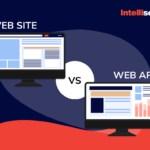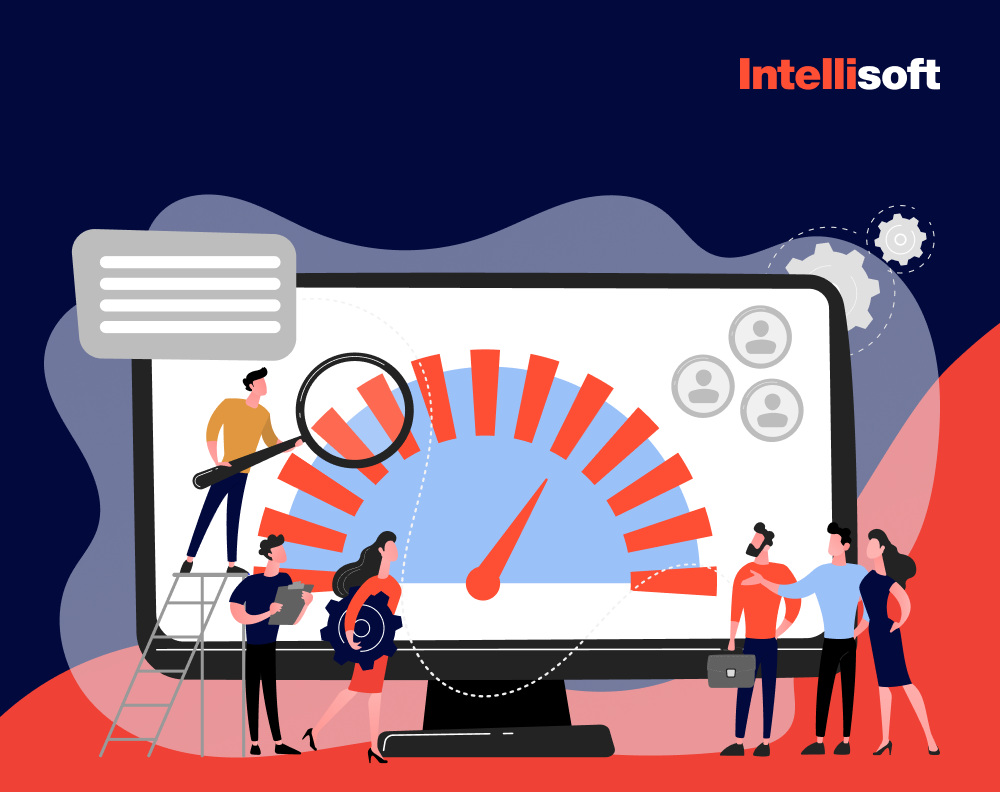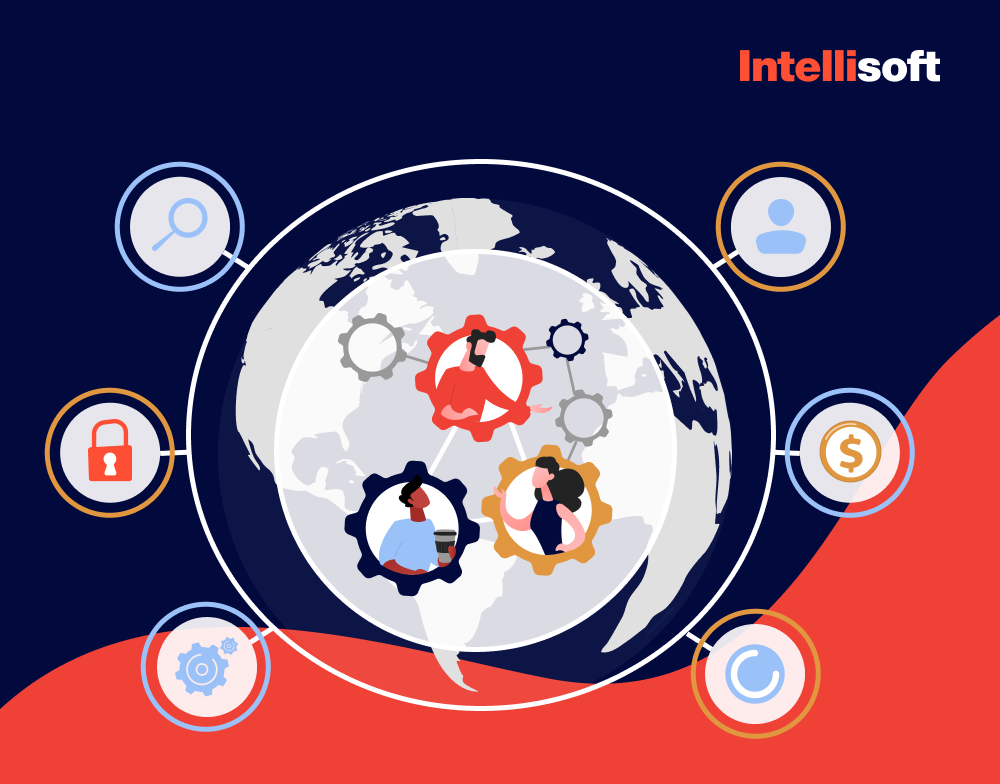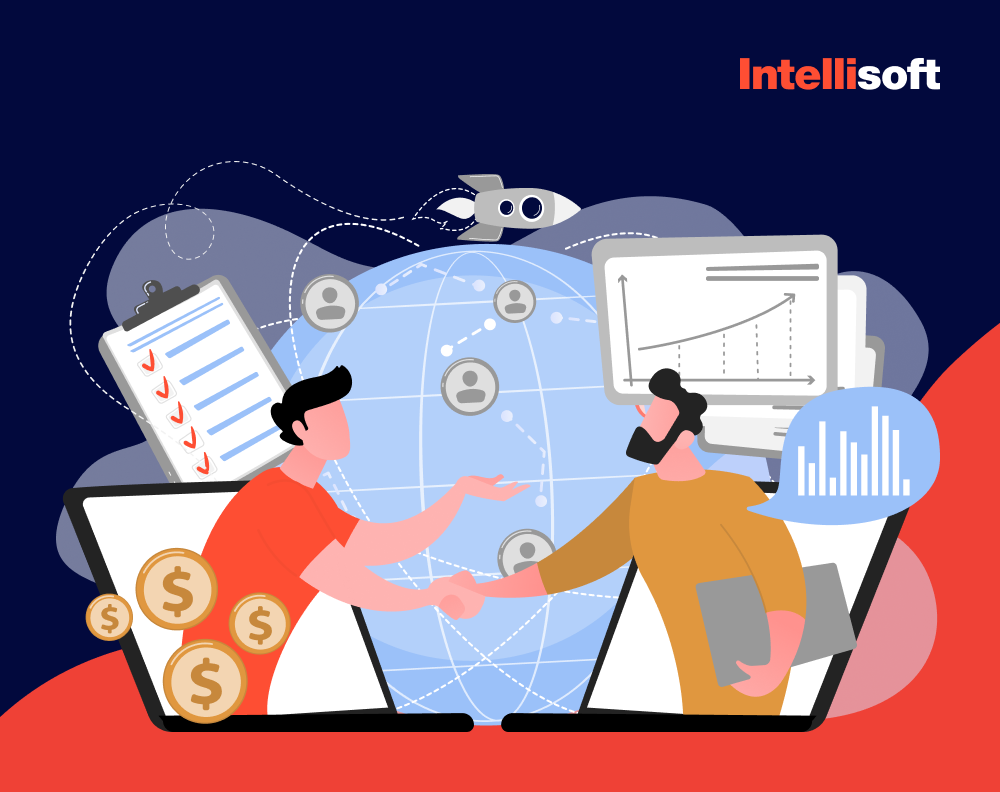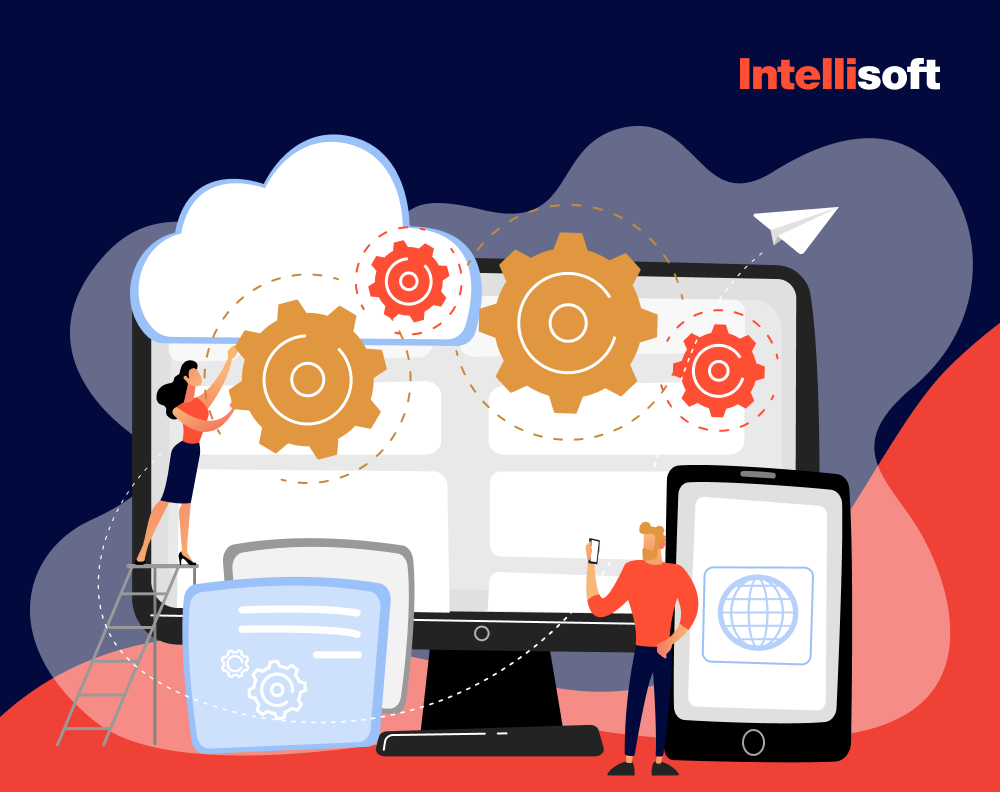The world of software outsourcing is very dynamic. Many businesses pull this strategic lever to stay competitive and innovative in the rapidly evolving tech scene. At IntelliSoft, we know the pros and cons of outsourcing and understand how to make strategic decisions that cut costs and infuse your projects with fresh, global perspectives by tapping into a vast pool of diverse talents.
Why should you consider software outsourcing? With more than 15 years of experience in software development, we can easily guide you through the labyrinth of potential benefits and pitfalls associated with subcontracting. This article will unpack the pros and cons of offshoring and outsourcing software development, providing you with the essential knowledge to determine if this strategy fits your business objectives.
From enhancing your scalability to navigating the challenges of communication barriers and security concerns, we’ll explore critical factors that could significantly impact your outsourcing effectiveness.
Table of Contents
Exploring IT Outsourcing: Definitions and Dynamics
Before we discuss the pros and cons of offshoring and outsourcing, we need to define the terms. IT outsourcing is when businesses hire outside companies to handle their IT tasks and services to help meet their business goals. This approach supports technical operations and is crucial in shaping business strategies.
In IT, when evaluating pros and cons of offshore outsourcing, we think about various services, such as utility services, Software as a Service (SaaS), and cloud-enabled outsourcing. The essence of IT outsourcing lies in its ability to help businesses develop effective sourcing strategies, select appropriate IT service providers, and structure beneficial long-term contracts. The ultimate goal is establishing and maintaining sustainable, mutually beneficial vendor relationships.
The benefits of IT subcontracting can be quite transformative. By leveraging external expertise, assets, and intellectual property, your business can significantly reduce costs and accelerate time to market. Outsourcing lets your company concentrate on what it does best while outside experts take care of the IT work.
Consider the case of Microsoft, a giant in the tech industry has evaluated all the pros and cons of outsourcing IT services. A substantial number of tasks are handled by contracted rather than in-house employees. By outsourcing the project management of its contract workforce, Microsoft ensures that its internal teams can focus on strategic and creative tasks. This approach optimizes productivity and innovation. This structure reduces the internal management burden and leverages external expertise to maintain operational efficiency. Through strategic subcontracting, companies like Microsoft demonstrate how integrating external resources can support and enhance business operations.
Key Outsourcing Models in IT
IT outsourcing typically offers businesses several engaging models catering to different needs and operational strategies. Let’s explore three primary models of IT subcontracting: Full Outsourcing, Classic Outsourcing, and Outstaffing.
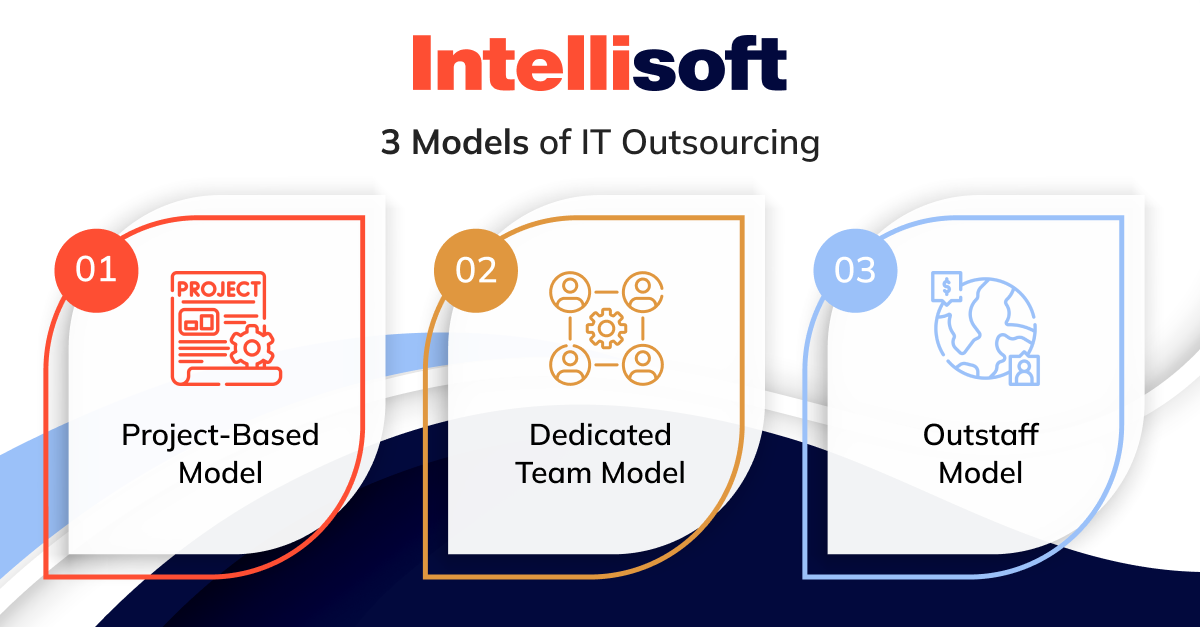
Full Outsourcing (Fixed Price Outsourcing)
In the full subcontracting model, also known as fixed-price outsourcing, the client hands over complete control of a specific project to the vendor. This model has well-defined parameters, including:
- Scope
- Deadlines
- Budget
Clients provide a comprehensive brief and set expectations upfront, allowing them to step back and let the vendor manage the project’s day-to-day execution. This model is ideal for projects with clear, unchanging requirements or when the client prefers not to dig into the granular details of the development process.
Classic Outsourcing (Dedicated Team)
Often referred to as hiring a dedicated team, classic outsourcing is a model where the client already has an in-house development team but chooses to extend their capabilities by partnering with a third-party provider. This arrangement allows the client to delegate parts of tasks or entire projects to an external team. Despite subcontracting the execution, the client retains significant control over the project, including:
- Management
- Planning
- Oversight
This model is particularly effective for companies looking to scale their operations quickly without compromising the oversight of critical business functions.
Outstaffing (Staff Augmentation)
Outstaffing, or staff augmentation, is a flexible outsourcing strategy where a company enhances its in-house team with remote employees. This model is typically chosen when a company needs to temporarily expand its technical capabilities or fill specific skill gaps without the overhead associated with full-time hires. The outstaffing personnel work as an extension of the client’s existing team, providing specialized skills and contributing to the project under the client’s direct supervision.
Each of these outsourcing models offers distinct advantages depending on the project requirements, the level of control desired by the client, and the nature of the tasks to be outsourced.
Who Uses Outsourcing?
Outsourcing has become a useful strategy for startups, small businesses, and large companies. The ability to access a vast pool of global talent and vast expertise without the overhead of traditional employment makes subcontracting a compelling option for businesses aiming to innovate, scale, and reduce costs effectively.
Broadening Access to Specialized Skills
The main reason companies turn to outsourcing is the immediate access it provides to specialized skills that might be scarce or too costly within their local labor markets. Whether it’s a part-time UX designer or a quality assurance specialist needed to test a new product, subcontracting companies are equipped to supply the right expertise at the right time. This flexibility helps businesses stay quick and responsive to market needs without being tied down by long-term commitments and employee costs.
Dispelling the Myths
Contrary to popular belief, outsourcing is not reserved for small businesses lacking in-house capabilities. Some of the world’s most renowned tech giants are assessing the cons and pros of outsourcing and leveraging this tool to enhance their capacity, streamline development processes, and accelerate time to market. The average global time to hire for IT and design roles can be extensive, often stretching into many hours and adding a significant workload for companies. Subcontracting can drastically reduce this time, freeing up internal resources and allowing companies to focus more on core business strategies than recruitment and administrative tasks.
Case Studies of Major Players
GitHub
In developing Gist, one of its core features, GitHub outsourced to Scott Chacon, who not only contributed to the feature but later became GitHub’s CIO. This move illustrates how outsourcing can also serve as a gateway to discovering key personnel who can provide long-term strategic benefits.
BaseCamp
Initially launched in 2004, BaseCamp faced significant challenges that were only overcome after a major application revamp handled by an outsourced team. This pivot was crucial for transforming the application into the globally recognized project management solution it is today.
Slack
Known for its sleek interface and efficient user experience, Slack also turned to outsourcing during its early days. Critical aspects of web design and content creation were handled by outsourced teams, laying the groundwork for what would become one of the most popular communication tools in the tech industry.
These examples underscore that subcontracting is a prevalent strategy among businesses of all sizes, including some of the biggest names in the tech industry. By embracing outsourcing, these companies have optimized their operational efficiencies and enhanced their product offerings and market adaptability.
Strategic Timing for Outsourcing IT Services
Outsourcing IT services is not just about following industry trends, it’s a strategic decision companies make to enhance their operational capabilities, manage costs effectively, and stay competitive in a fast-evolving market.
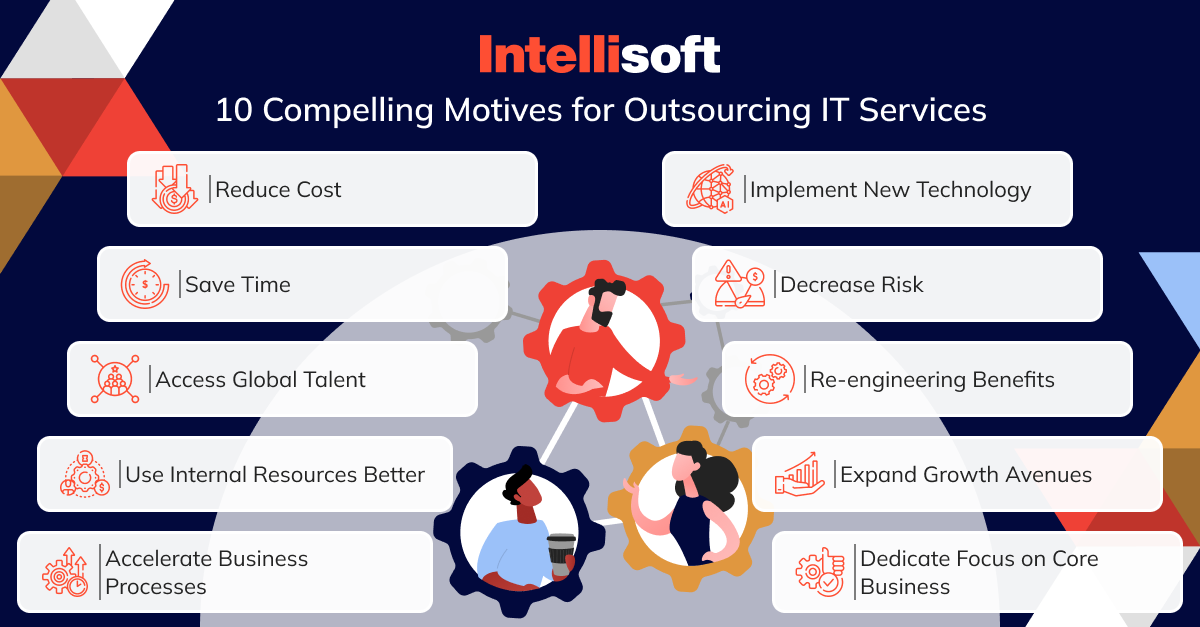
Here are several key scenarios when companies typically decide to outsource their IT functions:
Cost Efficiency and Reduction
One main reason for outsourcing IT services is to save money. Companies can reduce costs related to hiring, training, and keeping an in-house IT team by subcontracting. Additionally, it removes the financial burden of ongoing investments in IT infrastructure and technology upgrades, making it an economically advantageous option.
Accessing Specialized Skills and Expertise
Outsourcing gives access to a global pool of talent, allowing businesses to find specialized skills and expertise that might be hard to find locally. This access is especially valuable for projects requiring niche skills or advanced knowledge that are critical for the company’s technology strategy but are not core to its primary business operations.
Enhancing Scalability and Flexibility
For businesses with changing needs, outsourcing lets them quickly and efficiently scale their IT operations. It helps companies adjust their IT capabilities without the long-term commitments and costs of expanding an in-house team. This scalability is crucial for companies adapting swiftly to market changes or project demands.
Focusing on Core Competencies
Outsourcing IT services allows companies to focus their internal resources on key business activities that promote value and growth. By delegating IT responsibilities to external experts, businesses can enhance their focus on strategic initiatives, boosting overall productivity and operational efficiency.
Ensuring Advanced Security and Compliance
Maintaining robust IT security is paramount in an era of wild data breaches and cyber threats. You have to weigh the pros and cons of outsourcing IT security. Outsourcing to providers specializing in advanced security measures can help ensure that a company’s IT operations comply with industry regulations and standards. This is especially important for industries with strict data security and compliance rules.
Improving Network Performance
Companies also opt for subcontracting to ensure their network infrastructure is robust and efficiently managed. Outsourced IT services often include comprehensive network maintenance, disaster recovery planning, and proactive support, which are crucial for maintaining high availability and performance.
Related readings:
- Outsourcing vs. Outstaffing Models: Their Pros & Cons
- IT Offshore Outsourcing: Key Pros and Pros
- How to Overcome Risks of Outsourcing?
- Outsourcing vs. Outstaffing Models: Their Pros & Cons
- In-House vs. Outsourcing Software Development Teams
Evaluating the Pros and Cons of IT Outsourcing
Many businesses now choose to outsource IT services to improve their operations and focus on their main strengths. While it has many benefits, it also comes with challenges that need careful management. Here’s a detailed look at the pros and cons of outsourcing software development to help you make an informed decision.
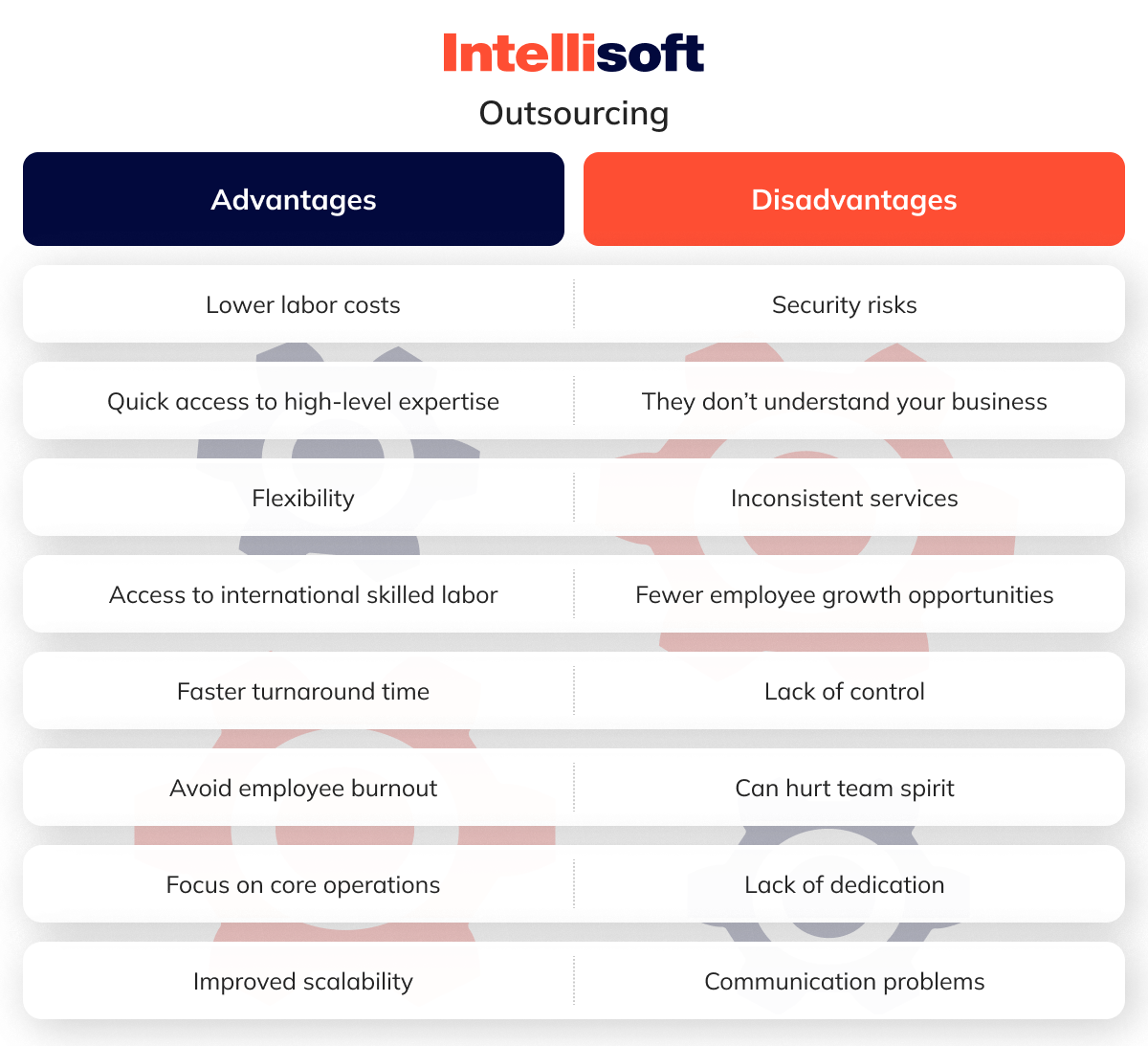
Pros of IT Outsourcing
Cost Savings
One of the main reasons to outsource IT is to save money. By subcontracting, businesses can turn fixed IT costs into variable costs and only pay for what they use. This approach reduces capital expenditures and decreases ongoing IT management costs, such as recruitment, training, and salaries.
Access to Expertise
Outsourcing opens the door to global talent and expertise that may not be readily available locally. Companies can benefit from the specialized skills of experts who are often more knowledgeable and experienced, ensuring that professionals handle IT tasks using best practices.
Scalability and Flexibility
Another advantage of outsourcing is scaling IT services to match business needs. Companies can easily increase or decrease their IT capabilities depending on their current requirements without hiring or laying off staff. Subcontracting provides tremendous flexibility and responsiveness to market dynamics.
Focus on Core Business
Outsourcing IT tasks lets companies focus on their main business activities without getting distracted by complicated IT decisions. This approach can improve productivity and allow the internal team to focus on generating business value.
Enhanced Efficiency
Outsourcing companies typically have access to the latest technologies and are equipped with advanced solutions that may not be economically feasible for many businesses to implement in-house. As a result, you can improve efficiency and achieve quicker turnaround times.
Robust Security and Disaster Recovery
Professional subcontracting firms often have stronger cybersecurity measures and disaster recovery plans than the client company might afford internally. This enhanced security infrastructure helps protect against data breaches and ensures continuity of operations.
Competitive Advantage
By leveraging the latest technologies and innovations through subcontracting, businesses can maintain a competitive edge. Outsourcing accelerates the implementation of new technologies, keeping companies at the forefront of advancements in their industry.
Cons of IT Outsourcing
Reduced Control
When outsourcing IT functions, companies might face reduced control over their operations. Relying on external entities can lead to a dependency that may not align with the company’s strategic objectives.
Potential Quality Issues
Quality of work is a common concern in outsourcing relationships. Discrepancies in standards and expectations can affect the final outcomes of IT projects.
Communication Challenges
Working with an outsourcing partner, especially one at a different timezone or with a different cultural background, can lead to communication barriers. These differences can result in misunderstandings and inefficiencies, impacting project timelines and outcomes.
Security Risks
While outsourcing can enhance security measures, it also introduces data privacy and intellectual property risks. To mitigate these risks, it is crucial to assess the pros and cons of IT security outsourcing and ensure that the subcontracting partner complies with all relevant regulations and standards.
Impact on Staff Morale
Outsourcing can lead to concerns among existing staff regarding job security or perceived devaluation of their roles. It can affect morale and productivity, creating an internal culture challenge.
So, what are pros and cons of outsourcing and offshoring? When you understand these pros and cons, your businesses can more effectively navigate the complexities of IT outsourcing, maximizing the benefits while mitigating the potential drawbacks.
IntelliSoft Case Studies
IntelliSoft has collaborated with diverse companies, tailoring subcontracting solutions that propel growth and innovation. Here, we explore three compelling case studies that illustrate the impact of our partnerships.
Cambio: A Strategic Leap through Outsourcing
Cambio (ex-Daintel), a startup at its inception, faced the classic dilemma of limited resources and the pressing need for rapid development. A coincidental introduction to the CEO from IntelliSoft catalyzed the decision to outsource, who brought invaluable expertise and connections. Despite initial reservations about cultural differences and potential communication barriers with outsourcing to Ukraine, Cambio’s partnership with IntelliSoft unlocked remarkable benefits.
IntelliSoft’s proactive management in candidate screening and recruitment process oversight allowed Cambio to concentrate on core business functions, facilitating substantial growth and leading to the company’s successful expansion. This collaboration gave Cambio access to top-tier talent and ingrained a robust foundation for handling subcontracting complexities, marked by a commitment to open communication and problem resolution.
GrowthWheel: Expanding Capabilities and Competitive Edge
GrowthWheel turned to IntelliSoft to overcome challenges related to scaling its development capabilities after previously relying on freelancers had introduced talent quality and project management inconsistencies. IntelliSoft’s intervention transformed these challenges into opportunities, enabling GrowthWheel to enhance feature delivery, retain clients, and attract new business, thereby boosting overall revenue.
The relationship with IntelliSoft provided more than technical staffing—it offered a stable, supportive, and strategically aligned extension of their in-house team. The CEO and the team valued this partnership at the corporate level and personally appreciated IntelliSoft’s leadership’s reliable, professionally compatible human resources and insightful business and technology advisories.
ZyLab: Accelerating Growth with Strategic Outsourcing
ZyLab faced significant recruitment challenges within the competitive Dutch tech market. Partnering with IntelliSoft, they leveraged previous positive experiences with Ukrainian developers to address their needs swiftly and effectively. IntelliSoft facilitated the rapid formation of a skilled development team that seamlessly integrated with ZyLab’s culture and significantly propelled the company’s growth initiatives.
This partnership underscored the benefits of long-term collaboration, providing ZyLab with a temporary solution and a sustainable strategic asset. The team from IntelliSoft became a core component of ZyLab’s operations, highlighting the seamless integration and mutual commitment that characterize successful outsourcing relationships.
Each case study demonstrates IntelliSoft’s capability to tailor outsourcing solutions that address immediate technical needs and foster long-term strategic growth. IntelliSoft ensures that outsourcing transitions from a tactical decision to significant business success through careful selection, cultural alignment, and continuous partnership.
Understanding IT Outsourcing Costs
Outsourcing IT services is a strategic decision influenced by various factors, including cost efficiency. Here, we break down the typical expenses associated with subcontracting IT and explore strategies to optimize costs and avoid hidden fees.
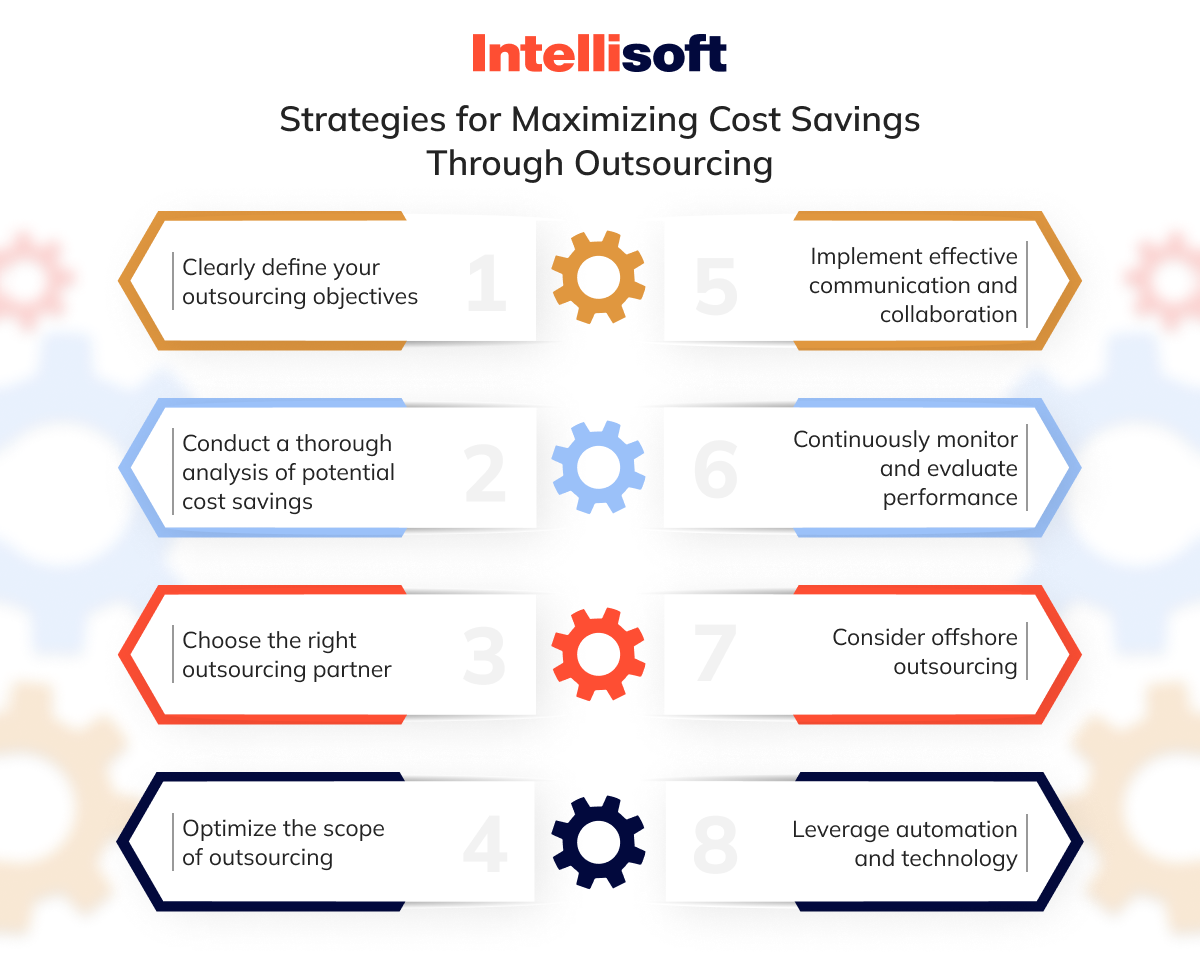
How Outsourcing Can Reduce Prices
Outsourcing IT services can lead to substantial cost savings, often a primary motivator for companies considering this route. The cost benefits come from several key areas:
Reduced Labor Costs
By outsourcing, companies can tap into global talent pools where labor costs are significantly lower than in their home countries. This difference is particularly notable when outsourcing to regions like Eastern Europe, India, or Southeast Asia, where professional rates are more competitive.
Economies of Scale
Outsourcing firms often service multiple clients, allowing them to distribute infrastructure and technology costs across projects. This scalability can translate into lower costs for individual clients.
Decreased Infrastructure Investment
Companies save on capital expenditure by setting up or expanding IT infrastructure. Outsourcing partners provide tools, software, and systems, reducing the client’s financial burden.
Operational Efficiency
External providers are specialists in their fields, with the processes and systems to deliver services efficiently. This expertise can lead to faster turnaround times and higher quality outputs, which are cost-effective in the long run.
A Gartner study highlighted that organizations outsourcing their IT services saved an average of 15% on their overall IT budgets, with 70% reporting specific cost reductions in areas like hardware and staffing.
How Can Hidden Costs Be Avoided When Outsourcing Software Development?
While outsourcing can be economically advantageous, hidden costs can emerge, impacting the overall savings. Here’s how to manage and minimize these potential expenses:
Conduct a Thorough Cost Analysis
Before embarking on an outsourcing project, perform an in-depth analysis to identify all possible costs, including direct and indirect expenses. Understanding these can help in budgeting more accurately.
Set Clear Expectations and Requirements
Ambiguities in project scope and deliverables can lead to scope creep, often resulting in additional costs. Clear contracts and detailed service level agreements (SLAs) are essential to align expectations and responsibilities.
Select the Appropriate Pricing Model
The pricing model should match the project’s nature. Fixed-price models suit projects with well-defined scopes, whereas time-and-materials or team-based models offer flexibility for projects with changing requirements.
Monitor Development Progress Regularly
Keep a close eye on the development process through regular updates and checkpoints. This proactive approach allows for the early identification of issues, preventing costly overruns.
Plan for Transition and Disengagement Costs
Be aware of the costs of transitioning services to and from the outsourcing provider, including training and knowledge transfer. Consider potential disengagement or cancellation fees as part of the contractual agreement.
Adapt to Technological Changes
Ensure the outsourcing partner can accommodate future technological shifts. This flexibility prevents additional costs associated with adapting or changing technology mid-project.
By considering these strategies, you can effectively manage the costs of outsourcing IT services, maximizing your investment while minimizing unexpected expenses.
Key Considerations When Selecting an IT Outsourcing Company
Picking the right IT outsourcing company is essential for meeting your business goals and making your outsourcing efforts successful. In the competitive business world, you need to consider several factors to make a smart choice. Here are nine essential factors to evaluate when selecting an IT outsourcing partner:
Factor 1. Quality of Outsourcing Services
Quality is paramount in IT outsourcing. Evaluate if the potential partner can meet and exceed your business needs by looking at their talent, certifications, and past project successes. High-quality services directly contribute to business success, making selecting a provider that consistently delivers excellence and innovation is crucial.
Factor 2. Outsourcing Costs and Price Model Transparency
While saving money is a big benefit of outsourcing, it’s also important to understand and have clear pricing. Ensure that the price model is justifiable and transparent, balancing cost and service quality. Research market rates thoroughly to gauge the fairness of the pricing offered by the subcontracting firm.
Factor 3. Location
The geographic location of your outsourcing provider can impact many aspects of the service, including costs, communication, and project management. Consider locations with cultural proximity, convenient travel options, and a thriving local market of skilled IT professionals. This strategic decision can significantly influence the efficiency and effectiveness of the outsourcing partnership.
Factor 4. Cultural Compatibility
The cultural fit between your company and the outsourcing provider is crucial. Corporate culture differences can pose challenges or offer benefits, such as innovative perspectives. Early assessment of cultural compatibility can help harness potential benefits while mitigating risks associated with cultural discrepancies.
Factor 5. Customers’ Reviews and Feedback
Investigate the outsourcing provider’s reputation through reviews and feedback from past and current clients. This information can provide insights into the provider’s reliability, work ethic, and ability to maintain long-term business relationships. Positive feedback is a strong indicator of a trustworthy and competent subcontracting partner.
Factor 6. Partnership Mindset
Look for an outsourcing provider that views the relationship as a strategic partnership rather than a vendor-client interaction. A partner committed to understanding your business goals and aligning their services accordingly can add significant value, making your investment more fruitful.
Factor 7. Technology and Infrastructure
Ensure the outsourcing provider uses the latest technology and has a robust infrastructure to handle your projects effectively. An on-site visit can help you assess their facilities and technology firsthand, giving you a feel for the company’s operational environment and culture.
Factor 8. Management Maturity
The outsourcing company’s leadership and management team should have a solid track record in technology and management. Experienced leaders can more effectively navigate the complexities of IT projects and foster a stable, productive subcontracting relationship.
Factor 9. Communication
Good communication is essential for successful outsourcing. Evaluate the subcontracting team’s communication channels, processes, and language skills. Clear and efficient communication will ensure that project requirements are fully understood and met and that any issues are promptly resolved.
By carefully considering these nine factors, you can significantly enhance your chances of selecting an IT outsourcing company that meets your immediate needs and becomes a valuable long-term partner.
Outsourcing Software Development with IntelliSoft
Outsourcing software development comes with its unique set of challenges and benefits. The pros and cons of outsourcing development to software firms need careful consideration to align with a company’s strategic goals. While the potential for cost savings, access to global talent, and increased operational flexibility are significant, the associated risks, such as communication barriers, security concerns, and reduced managerial control, also demand attention.
IntelliSoft stands out as a distinguished leader in software development outsourcing. We offer tailored solutions that mitigate these risks while amplifying outsourcing’s inherent advantages. Our reputation as a dependable partner stems from our commitment to delivering excellence and our proven track record in managing sophisticated software development projects across various industries.
We pride ourselves on our ability to integrate seamlessly with your operations, enhancing your technological capabilities without the overheads associated with scaling in-house teams. Our approach focuses on understanding your business needs deeply and delivering efficient, innovative, and forward-thinking solutions. Our security measures are rigorously designed to protect your data and intellectual property with the utmost integrity.
Choosing to partner with IntelliSoft means opting for a service that extends beyond mere technical execution. It means engaging with a partner invested in your success and equipped to handle the complexities of software development outsourcing. Contact us to transform your software development strategy and achieve your business objectives.
